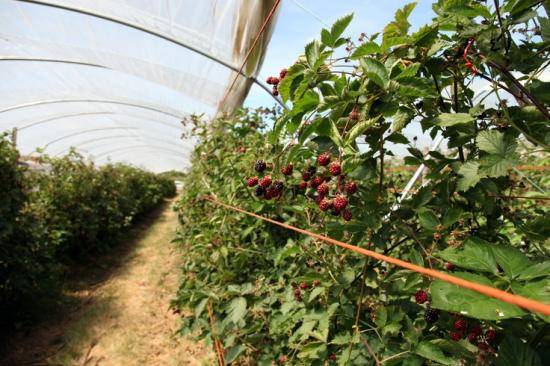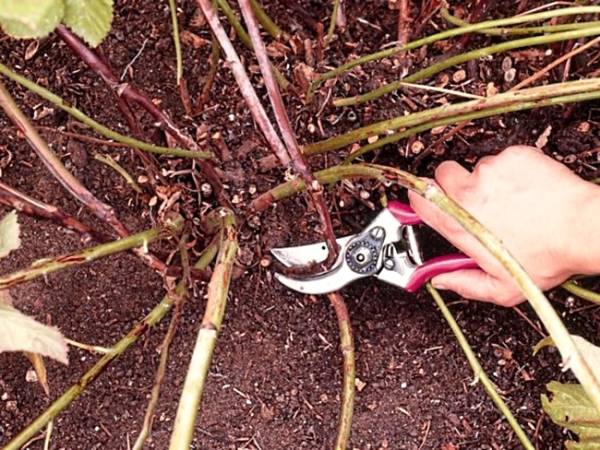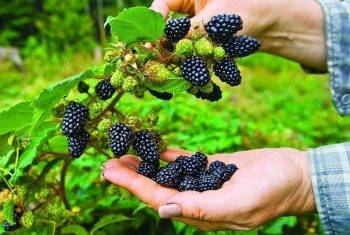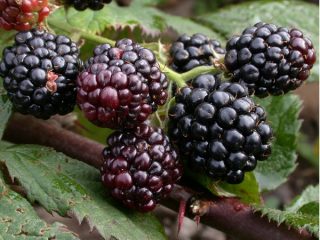Content
- 1 What does productivity depend on?
- 2 How to plant blackberries
- 3 How to plant blackberries correctly
- 4 Caring for blackberries in spring: advice from experienced gardeners
- 5 Planting and caring for blackberries in the Leningrad region
- 6 Blackberries in the Urals: planting and care
- 7 Blackberries in Siberia: planting and care
- 8 Feeding and fertilizers for blackberries
- 9 Diseases and pests, methods of control and prevention
- 10 Conclusion
If you decide to plant blackberries in your garden plot, there will be no difficulties with caring for the crop. The plant requires a little attention in autumn and spring, and in the summer it thanks with a generous harvest. According to the structure of the bush, blackberries can be erect or climbing. Now many remontant varieties have appeared, even without thorns on the stems. To help a novice gardener, step-by-step instructions for planting blackberries in the spring are offered, as well as an overview of the nuances of caring for the crop.
What does productivity depend on?
The quantity and quality of the blackberry harvest depends not only on the variety. Experienced gardeners have developed 4 important rules for themselves:
- It is better to plant blackberries in trenches. The soil remains moist longer, and fertilizers reach the roots better.
- Large berries grow from abundant feeding with humus.
- Pruning is done so that there is no thickening and excessive load on the bush.
- Proper covering of bushes for the winter saves fertile buds from rotting and shoots from freezing.
Following these simple rules will help you get a big harvest.
How to plant blackberries
To enjoy delicious black berries, you need to know the rules of planting and caring for the plant. The culture is considered two years old. The first year fruit shoots grow on the bush. The following year, these stems send out flower stalks, becoming fruiting branches. Often, a novice gardener is primarily interested in the question: what year will blackberries bear fruit after planting a seedling? Here you can give the exact answer - in the second year.
During the growing season, the bushes grow many shoots. Excess branches are removed, but the strongest ones are left. These will be replacement shoots that will bear fruit for the next season. The stems of the bush that bear fruit this year are cut off at the root in the fall.
Beginning gardeners may have another important question: why don’t garden blackberries bear fruit or very few berries, after all, a good seedling was planted on the plot?
There are several explanations for this problem:
- Feature of the variety. The plant can bear large berries, but in small quantities.
- Improper preparation of the bush for wintering. Violation of technology leads to freezing of fruit buds and branches. Due to the late removal of the cover, the kidneys leak.
- Incorrect pruning of the bush. If a gardener accidentally removes fruit branches, there will be no harvest next year.
- Incorrect watering. The plant really needs water only when pouring berries.
- Ignoring the garter of the bush to the support. If the lashes are left on the ground, the berries will be affected by gray rot. Productivity will decrease, and next season there may be no berries at all.
Planting and caring for blackberries is reminiscent of raspberry farming techniques. The bushes are planted in sunny areas with light shade.
Preparatory activities
In cold regions, it is recommended to plant blackberries in the spring so that the seedling has time to gain strength over the summer. Preparatory activities begin in the fall. The bed is dug up using the bayonet of a shovel. Apply per 1 m2 50 g potassium, 10 kg compost, 100 g superphosphate. Sand and peat are mixed into heavy soil.
Supports are prepared in advance before planting seedlings. It's better to do it for blackberries trellis. Poles 1.5 m high are driven in on both sides of the bush. A wire is pulled between them every 50 cm. You will get three rows. For tall varieties, poles up to 2 m high are dug in and four wire tensions are made.
When is it better to plant garden blackberries: in spring or autumn?
Each planting period has its own advantages and disadvantages. First of all, the climate of the region is taken into account. In the south, it is better to plant a seedling in the fall. The plant will take root and get stronger before winter.
In the northern regions, autumn seedlings do not have time to gain strength and freeze out. It is best to plant blackberries here in the spring. The seedling will grow stronger over the summer, form a bush, and bring a harvest the next season.
Planting dates for garden blackberries
In the southern regions, the optimal time for planting blackberries is October - early November.In the Leningrad region, Siberia and the Urals, seedlings are planted from mid-May, when the soil warms up well.
Where to plant blackberries on the site
Choose a site for blackberries that is well lit by the sun. At the dacha, the best place is considered to be the line along the fence, but 1 m away from the fence. For blackberries on the site, it is better to choose the south or southwest side.
The crop grows well on loamy soil with a fertile layer at least 25 cm thick. The roots go deep into the ground, so groundwater levels above 1.5 m are detrimental to the plant. The shrub grows poorly in salt marshes, marshy areas, stones and sand. Depleted soil requires good fertilizing with organic matter before planting seedlings.
What crops can and cannot be planted next to blackberries?
Blackberries enrich the soil with nitrogen. The apple tree is considered the best neighbor. Additionally, cultures provide each other with mutual protection from diseases.
You cannot plant blackberries near a strawberry bed. The neighborhood will lead to the proliferation of the worst pest of both crops - the weevil.
The close proximity to raspberries is considered a controversial issue. Crops tolerate each other, but they have common pests and diseases. You can plant blackberries next to raspberries in the country if there is a problem with a lack of free space.
Selection and preparation of seedlings
When planting blackberry seedlings in the spring, it is important to choose the right viable planting material. In order not to doubt the variety, it is better to make a purchase by visiting the nursery.
A strong seedling is recognized by the presence of developed 3-4 roots more than 10 cm long. A basal bud must be present. The above-ground part is considered good if there are two stems with lush green foliage.The seedling is inspected for the absence of mechanical and bacterial damage.
How to plant blackberries correctly
When preparing a bed, you need to know what distance between bushes and rows when planting blackberries is maintained for comfortable plant growth. For upright varieties, a gap of 1 m is maintained. A minimum of 1.5 m of passage is left between climbing bushes. Row spacing is from 2 to 3 m.
The holes are dug 15 days before planting. The depth and width of the holes is at least 40 cm. 5 kg of humus, 40 g of potassium, 120 g of superphosphate are added to each hole. On loamy and heavy soils, the root collar of the seedling is deepened to 2 cm. If the site is sandstone, the seedling is planted with the root collar deepened to 3 cm.
After filling the root system with soil, the blackberry seedling is watered with 6 liters of warm water. The hole should not be filled to the top with soil. Leave a depression of about 2 cm for watering. The tree trunk area is mulched with peat or rotted dry manure. The young seedling is regularly watered for 50 days after planting.
Caring for blackberries in spring: advice from experienced gardeners
Blackberries have long roots that go deep into the ground. The plant copes with drought, but needs to be saved from frost by covering the bushes. Caring for the crop is simple, but requires compliance with the rules.
The basis for obtaining a good harvest is proper pruning of the bush. The plant can throw out flower stalks even in the first year of planting. All flowers are cut off so that the bush gains strength. Initially, the seedling planted in the spring is cut off, leaving a stem 30 cm high.By autumn, fruiting shoots will grow. In the spring they are shortened by 15 cm. In the summer these branches bear fruit, and in the fall they are cut off at the root. 7–8 strong replacement shoots are left from the shoots. They will bear fruit next year. The further cutting cycle is repeated. In summer, remove excess growth that thickens the bush.
After pruning, the blackberry vines are tied to the support. The formation of a bush on a trellis is done according to the following schemes:
- Fan. Young replacement shoots are fixed to the wire in the center, and fruit-bearing branches are sent to the side.
- Rope. The pattern is similar to a fan, only the fruiting branches going sideways are woven together in two pieces.
- Wave. The young shoots are fixed in the center and allowed to weave sideways along the top wire of the trellis. Fruiting branches are allowed to trail sideways along the lower wire from the ground.
Dividing the bush into fruiting branches and replacement shoots simplifies pruning and harvesting.
Nitrogen is required from fertilizing in the spring to stimulate the growth of the bush. Every 3 years, 10 kg of compost, 100 g of superphosphate, 30 g of potassium are added to the plant. Along with fertilizing, gardeners advise spraying blackberry bushes with a 1% solution of Bordeaux mixture.
The plant only needs watering when the berries are pouring. For a week, 20 liters of water are poured under the bush. The long root is capable of independently obtaining moisture. Before and after fruiting, blackberries can be watered once.
Watering is usually combined with the application of fertilizer. After water is absorbed, the soil is loosened to a depth of 10 cm. The tree trunk area is covered with mulch.
Winter shelter for blackberries is carried out until the street temperature drops -1OC. The best material is considered to be spruce branches. The needles prevent rodents from breeding under cover. Non-woven material paired with film works well.Corn stalks are suitable plants for shelter. Straw and fallen leaves are not the best option. Such organic matter is saturated with moisture and is the best habitat for voles.
The video details how to cover blackberries for the winter:
Planting and caring for blackberries in the Leningrad region
A peculiarity of the region's weather conditions is the absence of snow in winter. For blackberries, the lack of a snow cover is detrimental. To prevent seedlings from freezing, it is better to plant them in the spring.
Blackberries in the Urals: planting and care
For the Urals, it is initially worth selecting frost-resistant regional varieties. Planting of seedlings is carried out in the spring, adhering to the bush method. The scheme allows you to protect blackberries from cold winds to the maximum. The tape planting method is allowed. To protect from winds, the rows on the north side are covered with agrofibre.
Blackberries in Siberia: planting and care
Planting and caring for blackberries in Siberia follows the same rules as in the Urals. Preference is given to upright varieties due to better frost resistance. Adapted well: “Darrow”, “Chester”, “Gazda”
Feeding and fertilizers for blackberries
To get a good harvest of large berries, blackberries are fed three times a season. In spring, they focus on nitrogen-containing fertilizers. 7 kg of humus and up to 40 g of ammonium nitrate are added under the bush. Mullein and a solution of bird droppings give good results.
In summer, blackberries are fed while the berries are pouring. The solution is prepared from 10 liters of water and 2 tbsp. l. potassium sulfate. Before fertilizing, the soil under the bush is sprinkled with wood ash at the rate of 1 cup per 1 m2. 7 liters of potassium solution are poured under each plant.Additionally, the bushes are sprayed with a solution of nitrogen, potassium and phosphorus.
In autumn, humus is dug into the ground under each bush - 1 bucket. From mineral fertilizers, add 40-50 g of potassium, 100 g of superphosphate. Just before covering the bush for the winter, the stems are sprayed with a solution of copper sulfate.
When, how and how much or what to feed blackberries in early spring
The initial application of humus and mineral complexes during planting of a seedling lasts the plant for three years. To develop the bush and get a good harvest, add organic matter and mineral fertilizers.
For active growth
Nitrogen-containing fertilizers accelerate shoot growth. In early spring, 15 g of urea or 25 g of ammonium nitrate are added to the bush. After the snow melts, the blackberries are fed with slurry or a solution of bird droppings. At 1 m2 adding 1 kg of organic matter. For further development, the plant needs phosphorus. Fertilizers are applied about 10 g.
To get a generous harvest
Fertilizing with 20 g of saltpeter and 10 g of urea allows you to increase productivity. At the beginning of fruiting, the leaves are sprayed with a solution of nitrogen, potassium and phosphorus. 6 liters of water with potassium sulfate are poured under each bush. The solution is prepared from 10 liters of water and 2 tbsp. l. fertilizers
Diseases and pests, methods of control and prevention
Blackberries are rarely affected by diseases and are attacked by pests, but the threat exists. Diseases usually occur when agricultural practices are violated.
Conclusion
Caring for blackberries is no more difficult than caring for raspberries. You need to get used to the bush, feel its need, and the plant will reward you with a generous harvest.






















